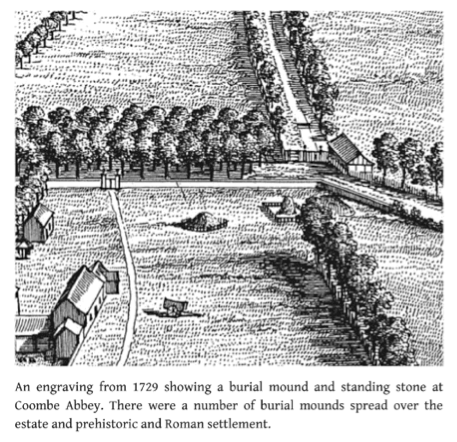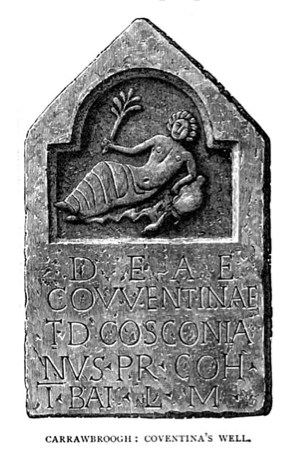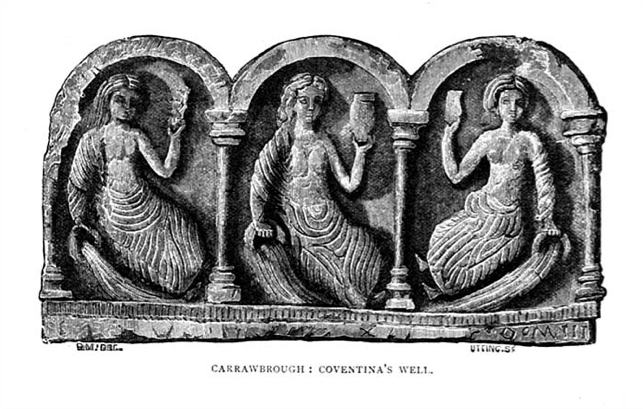An A-Z of Roman Coventry: C-E

Canley Ford – Romano-British Pottery
Nine sherds of Roman pottery were found in a hole dug through a bank and ditch at the edge of Hearsall Common Golf course. 1996.
Fabric grey wares and buff sandy ware. Found filling a hole dug by local youths to make cycle ramp. Hole dug in bank of a ditch and bank presently forming part of the boundary of Hearsall Golf course.
Chapelfields - May 1913, T S Burbidge records finding Romano-British pottery, including part of a patera – used in libations?
Coombe Abbey – very W Coventry

Coventina
Pauline writes: "Coventry perhaps derives from a word 'couan' meaning 'where the waters meet' (the river running through it which is now the Sherbourne was once called the 'Cune'). That feels like a strong possibility and, in that case, it is highly likely that the name Coventina came to be linked to the place."
Carrawburgh – real stuff…
Coffa Tree? McGrory - Coventina, being a water goddess, would have been at home in Coventry with its rivers, pools and springs: she was depicted naked or half naked holding a plant and pouring water from a jug or urn. An ancient coin-like object was discovered near the Priory Mill in New Buildings in the last century. This had on one side, a woman pouring water from a jug, and on the other a naked woman with a flower at her feet. It is possible that this has some connection with the legend."
https://en.wikipedia.org/wiki/Coventina
This sanctuary, discovered by Clayton in 1876, is the source of the stream. The well is known for the findings of over 13,000 coins, sculptural reliefs, and altars. It was built c.AD128-133, during the construction of the Vallum, in order to help control the water level of the area, it is likely after this it became associated with Coventina with the height of the cult being in the late 2nd to early 3rd centuries[10] when the Batavians were stationed at the fort.


Links with Cuda or Cune – same as Coventina? Couaen (Cune) meeting place of waters – the waters being the Sherbourne. Try is a place, not a tree, as in tryst.
Shrine of Cuda in Bagington? And where is the medal? (Cuda – Godiva?) Cuda in name Cotswolds?
Cox Street - Possible Roman river crossing W of Cox Street
But maybe main one was Bishop’s Street?
A collection or Roman objects was recovered from the silts of the River Sherbourne west of Cox Street. They were thought to come from a lady's bag or box of belongings and suggest that this may have been the site of a Roman ford across the river.
1> Cox Street excavations: It is probable that a Roman road ran through this site. With Mancetter on the north, and Baginton to the south, …it is quite possible. Whatever may be the answer, it would appear that the Romans crossed here before any bridges were made. In my first article I mention that about 6ft of rubble was below the river. Beneath this, in the gravel bed of the river was found a coin of Emperor Galinus [253-288], a bronze ring, jet ring, toilet set.., surgeons needles, pottery, iron handles, bronze for beating out etc...
2> Found a number of articles on the floor of the lake , and river bed at a depth of 16ft. … As the men excavated in the silt of the river bed, a coin of Emperor Galinus 253-268AD came to view. I then watched closely and many Roman articles were found…The British Museum states the articles found would be the contents of a Roman lady's box or bag. The bronze key was found.
J B Shelton
<1> Austin's Monthly Magazine of Instructive and Useful Information, 1932-1939, Extracts from "Austin's Monthly Magazine" of articles written by Mr J.B. Shelton 1932 - 1938, Vol.XXVI No.315 (--ARTICLE). SCT1615.
<2> J. B. Shelton, 1949, The Story of Twenty-Two Years Excavations in Coventry, p.10 (-MANUSCRIPT). SCT1614.
FCT369 - COIN (Roman - 43 AD to 409 AD)
FCT372 - COSMETIC SET (Roman - 43 AD to 409 AD)
FCT370 - FINGER RING (Roman - 43 AD to 409 AD)
FCT371 - FINGER RING (Roman - 43 AD to 409 AD)
FCT375 - KEY (LOCKING) (Roman - 43 AD to 409 AD)
FCT373 - NEEDLE (Roman - 43 AD to 409 AD)
FCT374 - SHERD (Roman - 43 AD to 409 AD)
Cross Point Cinema, Walsgrave (NE Cov) - Roman Building
The site of a possible Roman building suggested by a spread of Roman tile, pottery and a small quantity of tesserae, which was observed prior to the construction of the Showcase Cinema in 1991. The exact location of the building within the cinema site is not known.
Cross-point cinema site 1991’. There was very little opportunity for anything other than observation – lots of Roman tile, pottery and a few tesserae from memory...Roman buildings possibly, but only surmised from a concentration of structural material on the ground.
Associated Finds
FCT439 - ROOF TILE (Roman - 43 AD to 409 AD)
FCT438 - SHERD (Roman - 43 AD to 409 AD)
FCT437 - TESSERA (Roman - 43 AD to 409 AD)
Cross Cheaping – statue?
Some rough (?) Roman pavement was discovered in the Cross Cheaping during excavations at the end of the last century. Victoria County Hist. i. 246.
Going up the hill towards Broadgate the track continues, Shelton uncovered part of it in the 1930s. Even earlier in 1820 a trackway believed at the time to be Roman was found here under a cellar and in the mid-19th century a statuette of the Roman god Mars was unearthed behind Cross Cheaping. Also Roman "vessels" were said to have been found here.
